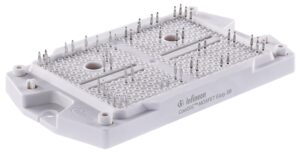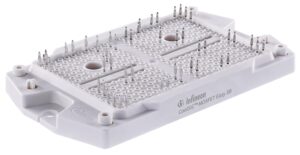Infineon Technologies has introduced a new CoolSiC technology to its lineup: the CoolSiC MOSFET 1200 V M1H. This advanced silicon carbide (SiC) chip will be implemented in a vastly extended portfolio using the popular Easy Module family – with discrete packages using .XT interconnect technology.
 The M1H chip offers high flexibility and is suitable for solar energy systems, such as inverters, that need to meet peak demand. The chip is also ideal for applications such as fast charging of electric vehicles, energy storage systems and other industrial applications.
The M1H chip offers high flexibility and is suitable for solar energy systems, such as inverters, that need to meet peak demand. The chip is also ideal for applications such as fast charging of electric vehicles, energy storage systems and other industrial applications.
The latest advancements in CoolSiC base technology enable a significantly larger gate operating window that improves endurance for a given die size.
Simultaneously, the larger gate operating window provides reliability against driver- and layout-related voltage spikes in the gate without restrictions even at higher switching frequencies. Along with the M1H chip technology, related enclosures have been adopted in technology and package variants to enable higher power densities and more options for design engineers to improve application performance.
Higher power density
The M1H will be integrated into the popular Easy family to further enhance the Easy 1B and 2B modules. In addition, a new product will also be launched that enhances the Easy 3B module with the new 1200V CoolSiC MOSFET.
Implementing new chip sizes maximizes flexibility and ensures the broadest industrial portfolio. With the M1H chip, the endurance of modules can be significantly improved, making devices more reliable and efficient.
Additionally, with a maximum temporary junction temperature of 175°C, overload capacity increases, enabling greater power density and fault event coverage. Compared to its predecessor, the M1, the M1H implemented a small adoption of the internal R G , allowing switching behavior to be easily optimized. Dynamic behavior is maintained with the M1H chip.
Ultra-low resistances
In addition to the Easy module family, the CoolSiC MOSFET 1200 V M1H portfolio includes new ultra-low resistances of 7 mΩ, 14 mΩ and 20 mΩ in the TO247-3 and TO247-4 discrete packages.
The new devices are easy to design, especially due to over- and underestimation of the gate voltage with the new maximum gate source voltage down to -10 V, and come with avalanche and short circuit capability specifications.
Infineon's .XT interconnect technology, previously introduced in the D 2 Package PAK-7L, is now also implemented in a TO footprint. Thermal dissipation capabilities are improved by more than 30% compared to a standard interconnect. As a result, this thermal benefit can be used to increase power output by up to 15%.
Alternatively, it can be used to increase switching frequency to further reduce passive components in EV charging, energy storage or photovoltaic systems to increase power density and reduce system cost.
Without changing system operating conditions, .XT technology will reduce SiC MOSFET junction temperature, significantly increasing system life and power cycling capabilities. This is a fundamental requirement in applications such as servo drives.
The new 1200V CoolSiC MOSFET M1H additions further increase the optimization potential for SiC-based applications, with rapid deployment of clean power and energy efficiency in a global world.

